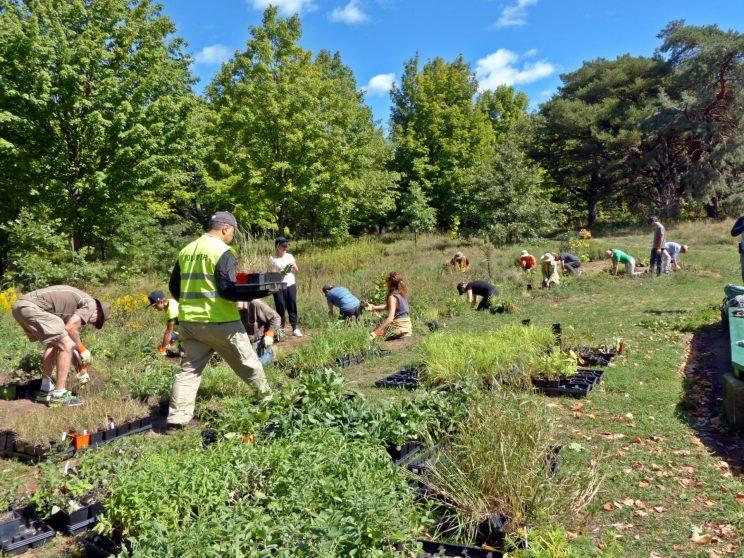by High Park Nature
The wetlands, ponds and creeks in High Park are fed mainly through surface water and groundwater. Surface water, mostly in the form of stormwater runoff, is captured, conveyed and discharged mainly through the City's storm sewer infrastructure. A small amount comes from runoff from surfaces within High Park itself. Another important source is groundwater - from shallow aquifers and seeps, and from deep underground stream-like systems, such as the Laurentian Channel.

Stormwater Facilities in High Park
In 2000, a different kind of wetland was built in the Lower Duck Pond. Its major function is to clean stormwater entering from Spring Creek. Separated from the rest of the Lower Duck Pond by a berm, the wetland contains cattails and other aquatic plants that help remove pollutants from water while providing habitat for wildlife.
Based on this model and other studies, a number of stormwater management facilities were constructed in the High Park/Ellis Avenue area in 2006 as part of the City’s Wet Weather Flow Master Plan. One of these facilities, located on the west shore of Grenadier Pond just north of the southwest cove, combines a sedimentation forebay with a wet pond/wetland area. The stormwater treated in this facility is expected to be cleansed of up to 80% of its suspended solids and associated heavy metals and bacteria before entering the pond.
Stormwater
In urban areas, the carrying capacities of the storm and combined sewer systems vary widely. One common factor is that the systems have difficulty handling the runoff from very infrequent and intense storms. Storm sewers are designed to intercept road drainage, through roadside catch-basins, during wet weather conditions and convey this runoff to the nearest receiving water body. However, because of the amount of impervious surface areas within urban areas, the runoff volumes and flow rates are substantially increased. In addition, wash-off from these hard-surface areas contains an enormous amount of contaminants. Area watercourses are impacted both by the physical and chemical stresses created by the flows. During dry weather, storm sewers can also be a direct source of contamination as a result of accidental or deliberate chemical spills to roadside catch-basins.
To reduce the environmental impact of storm sewer discharges, the City has embarked on a number of initiatives, including:
- implementing new technologies for stormwater treatment such as the Spring Creek/Lower Duck Pond – High Park Storm Water Management facility;
- using traps in roadside catchbasins to capture floatable material (e.g. oils and debris);
- disconnecting downspouts from the roofs of buildings.
Spring Creek and Sedimentation Ponds
Stormwater from a 248-hectare urban drainage area (bounded by Bloor St. West on the south, Lansdowne Avenue on the east, St. Clair Avenue on the north, and Clendenan Avenue and Runnymede Road on the west), enters High Park at its northeast comer. These storm flows contribute a large portion of water that supports the Spring Creek system. Spring Creek is the most prominent natural feature on the east side of High Park and is a significant echo of Toronto's pre-settlement environment. The creek follows a natural course originally carved through sand dunes bordering Lake Ontario.

Ridout Pond Odour Remediation Project 2020
Two aerating devices were installed in Ridout Pond to address odour concerns. This required the installation of a hydro facility on the south shore of the pond. The aerating devices were subsequently removed.
Sources
- High Park: Restoring a Jewel of Toronto’s Park System (PDF), Kidd, Christensen and McEwen, Forestry, Parks and Recreation Division, City of Toronto, 2000. Revised and updated January 2008.
See also
- Natural History of Toronto's High Park
- Wendigo Creek and Wendigo Pond in High Park
- Spring Creek
- Laurentian River
- Geology of High Park
- High Park Underground
Additional resources:
- High Park Surface Water Features - Narrative prepared for Bloor West Village Avenue Study, February 2018
- City of Toronto's Wet Weather Flow Management Master Plan 2000 - Environmental Assessment Study relating to Ellis Ave./Grenadier Pond projects:























